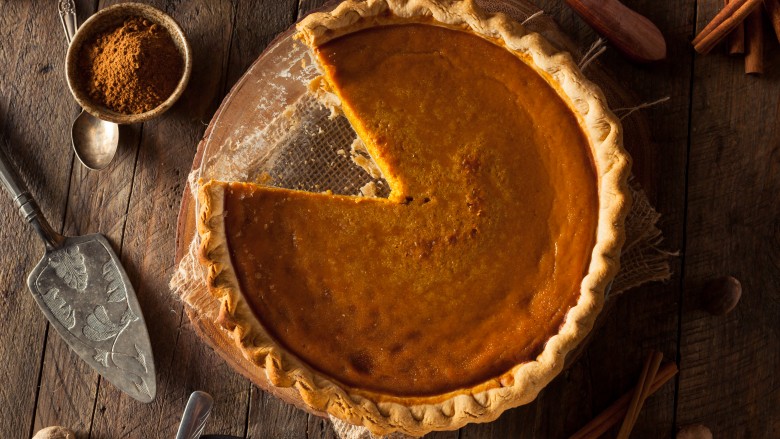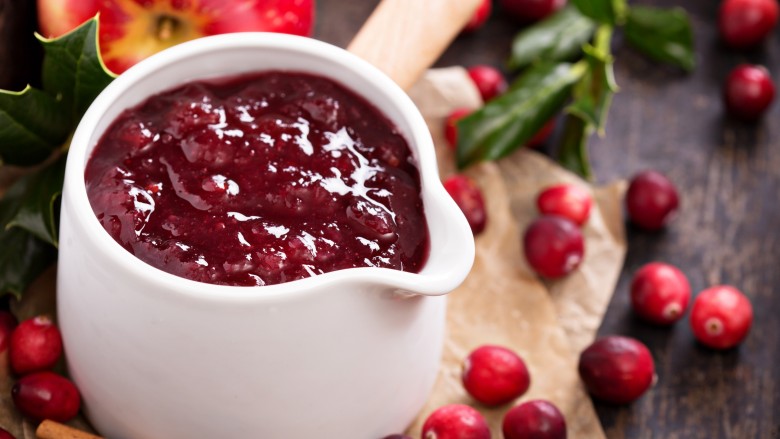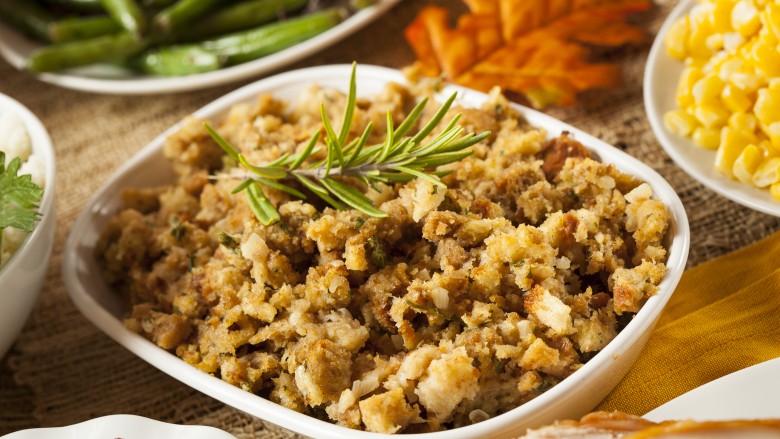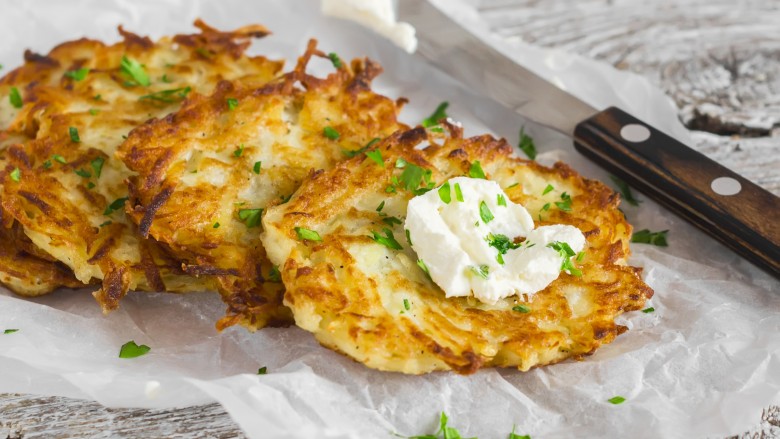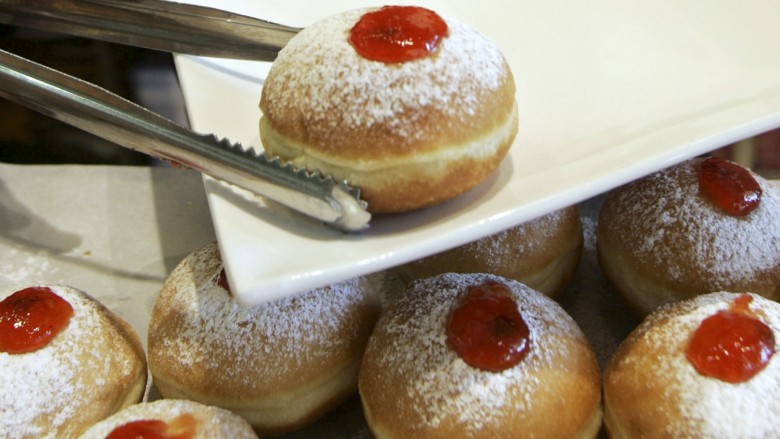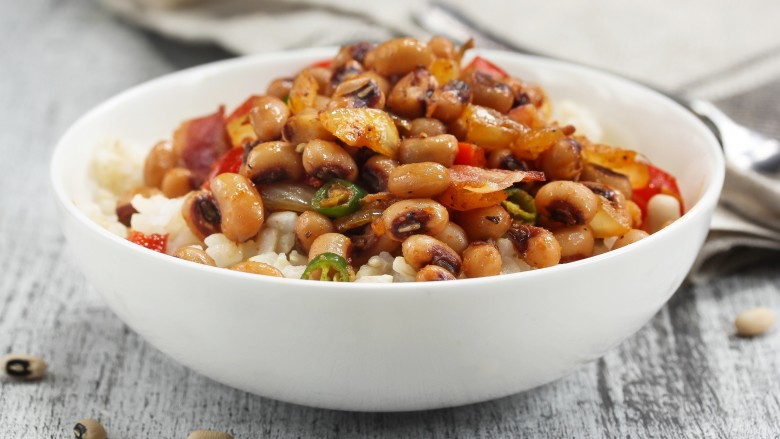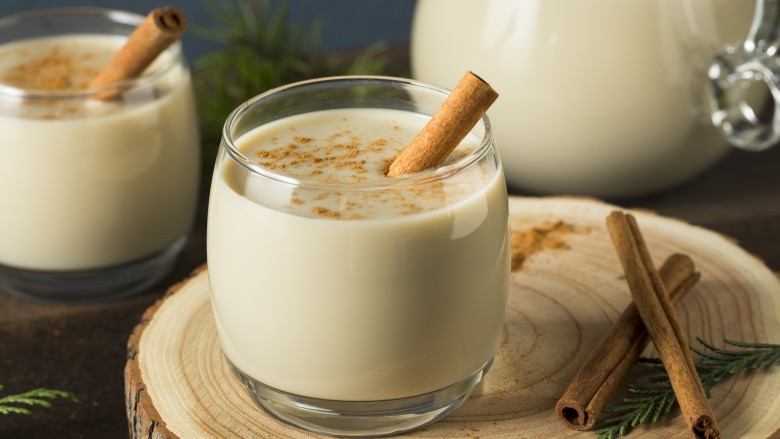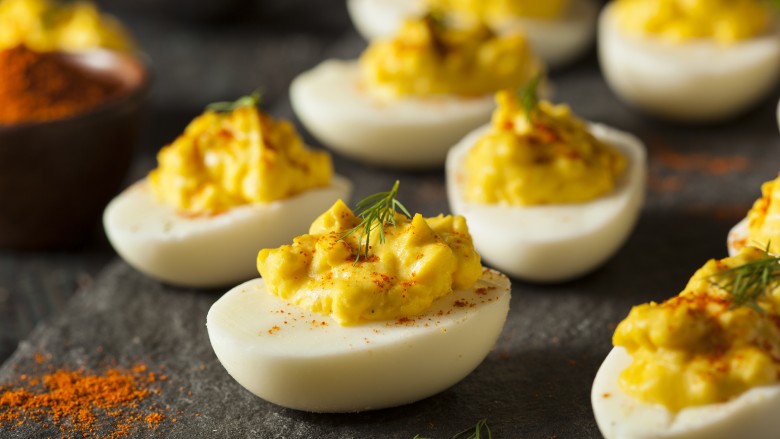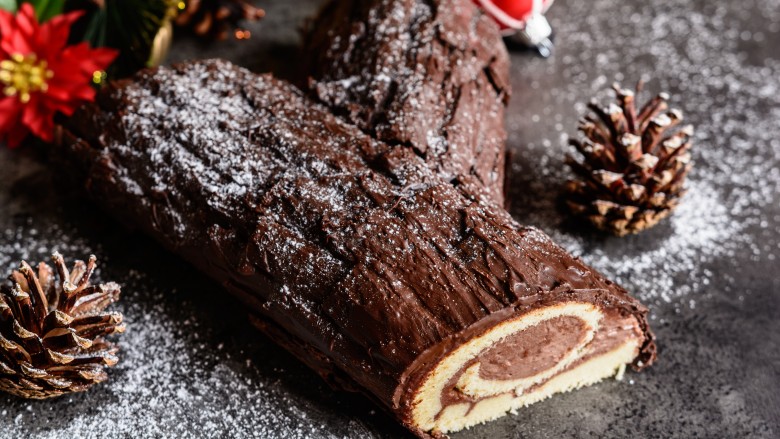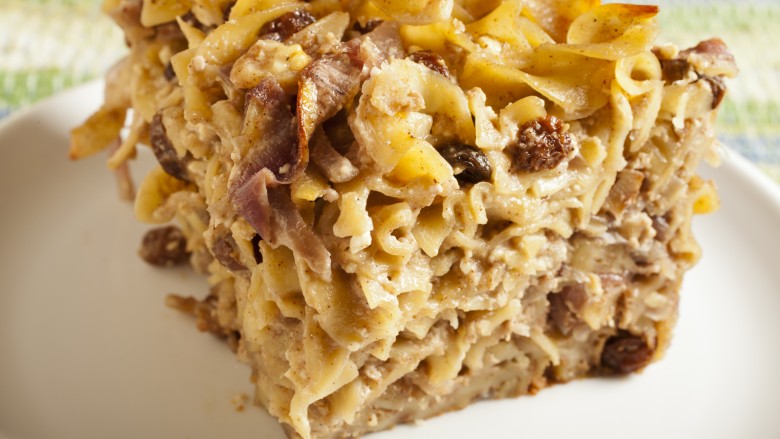Delicious Foods We Should Be Eating Year-Round
When it comes to food, sometimes breaking the rules can lead to delicious good times. If you can't get enough of seasonal dishes traditionally reserved for particular holidays, I'd encourage you to improve your quality of life significantly by enjoying them more often during the year. Whether you live for Thanksgiving stuffing each year, crave crispy latkes in the middle of summer with Hanukkah still months away, or think often of guzzling eggnog but could skip the Christmas fuss, there's no hard and fast rule that prohibits you from eating and drinking as you please 365 days of the year.
While some ingredients might have been scarce during a certain historical period and others may not have been available at all, circumstances have probably changed since. The modern age has provided people with much more flexibility where food is concerned, allowing you to make many traditionally seasonal dishes at other times during the year. Be your own food boss when you forgo tradition in exchange for culinary freedom — and bliss. Read on to understand where some of the holiday food traditions we hang on to come from, then decide to forge your own path if that's your kind of thing. How could you go possibly regret year-round pumpkin pie, sweet-tart cranberry sauce on the reg, and Hoppin' John whenever your heart desires?
Pumpkin pie
While most of us think of pumpkin pie as an iconic Thanksgiving dessert today, you might be surprised to know that this rich custard pie was probably not part of the first Thanksgiving of 1621. Without the butter and flour required for pie crust or even an oven for baking, the Pilgrims probably didn't enjoy pie after their feast the way we do now. Since pumpkins and other native squashes were available, they were more likely to have hollowed-out pumpkins and cooked a warmly spiced makeshift custard over ashes. So how did pumpkin pie become a Thanksgiving tradition if we can't attribute it to the Pilgrims? The Washington Post reports that in the mid-1800s a magazine editor by the name of Sarah Josepha Hale was researching the original Thanksgiving feast and set out to create a menu that could be replicated annually for the occasion. The recipes she published included turkey, stuffing, and (of course) pumpkin pie.
Even though pumpkin pie may not have been a part of the first Thanksgiving, the real question is why don't we make and eat it year-round? It's creamy, rich, and delicious like many custard pies are, so let's treat it like others in its category. From where I sit, relegating pumpkin pie to one holiday limits everyone's enjoyment of this delectable dessert. Moreover, if you consider that most pumpkin pie recipes in the United States call for canned pumpkin puree anyway, the seasonality becomes a moot point. The way I see it, a sweet slice of pumpkin pie is as good on a Tuesday afternoon in April as it is on the fourth Thursday of November. Who's with me?
This pumpkin pie recipe is not for the faint of heart. It is deeply spiced with loads of peppery notes, yet simultaneously remains wonderfully classic and rich. Make it for Thanksgiving or anytime you like.
Cranberry sauce
The turkey may be the main attraction at the Thanksgiving table, but those perfect sides sure make everything, look, smell, and taste more bountiful and festive. One side you're likely to find as part of any holiday spread is the ubiquitous dish of cranberry sauce, which only ever seems to appear on this November holiday. While sugar wasn't easy to get in the Northeast during the 1600s, cranberries were certainly around. According to Martha Stewart, the Pilgrims and the Wampanoag tribe people may very well have eaten these vibrant red berries crushed and served with meat, not in the form we now recognize at our own Thanksgiving tables. Even so, by the Civil War, cranberry sauce made by cooking berries with sugar and water had become widespread.
Closely associated with Thanksgiving, I often wonder why we don't serve cranberry sauce at other times, too. Its sweet, tart flavors have the magical ability to balance the heartier, more savory flavors of most meats and veggies, which makes it ideal for enjoying with foods other than turkey, amiright? There's no real reason now to reserve cranberry sauce for Thanksgiving alone, especially when you'd be just as thrilled to have a heap of it alongside roasted chicken or any variety of roasted seasonal vegetables. Let's bring this vibrant side out more often as an easy way to add a delicious twist to any meal.
This cranberry sauce recipe from Serious Eats is easy enough to encourage you to make it every chance you get. The tart flavor of cranberries is perfectly balanced by citrus notes along with warm cinnamon.
Stuffing
Let's consider the role of Thanksgiving stuffing — or "dressing," as some of us like to call it. Whether cooked directly inside the turkey or baked separately as is more common now, this side dish of seasoned bread chunks soaked in stock along with aromatics is one that most of us live for. I certainly look forward to second and third helpings of stuffing more than I do any other food at Thanksgiving. Whether you make your stuffing with cornbread, incorporate sausage, or add fruit, this dish has been around since the Middle Ages even though it didn't become a Thanksgiving tradition until the 1830s. Oyster stuffing, shoved beneath the turkey's skin, gained popularity later in the 19th century. While we don't know whether stuffing was served at the first Thanksgiving, turkey and rice were around, so it's entirely possible that cooked fowl was served with some type of rice dish alongside.
Whatever the exact origins of stuffing, there's certainly no reason to deprive ourselves of this incredibly flavorful dish for 364 days each year. Since food safety issues have encouraged many cooks to prepare stuffing separately from the bird anyway, stuffing can and should be enjoyed whenever you feel like eating it. I find that stuffing is a great dish to prepare when you have leftover bread along with a handful of other veggies and ingredients you want to use up. Since it's so easy to prep, we should be eating this delectable dish way more often. You heard it here first.
If you want to eat stuffing every other day like me, then you definitely need to add this delightful apple-herb stuffing recipe to your repertoire. Incredibly fragrant and ridiculously hearty, this dish is perfect for weeknight comfort.
Latkes
During the Jewish Festival of Lights known commonly as Hanukkah, enjoying lots and lots of fried food is just one perk of commemorating the small amount of ceremonial oil that miraculously kept candles lit for eight days during the time of the Maccabees. From jelly doughnuts to latkes, there are plenty of delicious dishes to nosh on during this time of year. Having been invited by Jewish friends to enough Hanukkah parties, I can attest to the appeal of latkes. These fried potato pancakes are crispy on the outside and perfectly tender on the inside. Often served with applesauce alongside, the portable snacks make for an ideal party food dish.
If you love the idea of enjoying hash browns for breakfast, baked potatoes for supper, and really anything starring potatoes any time, you might understand why I strongly feel that latkes can be eaten year-round with no adverse effects. While I can understand the ceremony and tradition of preparing latkes only during Hanukkah, I also believe we should spread the latke love throughout the year. Good food should always be celebrated.
Need some latke recipes to convince you that you should be eating latkes year-round? Look no further, reader. Learn all the tricks to getting latkes perfectly crisp.
Sufganiyot
Like latkes, sufganiyot — aka jelly doughnuts — are traditionally enjoyed during Hanukkah as one of the fried foods meant to commemorate the miracle of the temple oil lasting for eight days. And similar to my feelings about impeccably fried latkes, I am a strong advocate for eating as many jelly doughnuts as possible all year-round. Sufganiyot are round yeast doughnuts piped with sweet jelly and fried to golden perfection, which makes them ideal eaten with coffee alongside for breakfast or as a devilishly good afternoon snack. Enough said.
Doughnuts can definitely be a regular food. Don't wait until Hanukkah to make this sufganiyot recipe from Epicurious. Soft, pillowy dough filled with jelly is crucial for maintaining mental equilibrium all year.
Hoppin' John
In the American South, Hoppin' John is a New Year's culinary tradition. Thought to bring about good fortune, this dish of black-eyed peas, pork, and rice has been eaten since the 1800s as part of the festivities for ringing in a new year. While no one knows exactly how this hearty dish became linked to New Year's luck and prosperity, some speculate that slaves first created the Southern specialty and ate it with collard greens (for money) and cornbread (for gold) alongside.
I love the deep, earthy flavors of Hoppin' John and make it often during the year. With only a handful of inexpensive and humble pantry ingredients, the rustic dish is able to transform gloriously into a satisfying meal the whole family can enjoy. An ideal dish for feeding a crowd, Hoppin' John ought to be eaten year-round at potlucks, picnics, and dinner parties. Let's increase the good fortune tenfold.
Check out this recipe from The New York Times and make a pot of Hoppin' John whether it's January 1 or not. Classic and meaty, this is bound to bring you some everyday good luck.
Eggnog
December marks the beginning of the season that involves Christmas shopping, holiday cards, rich foods, parties, and sweet, sweet eggnog. Made with eggs, milk, sugar, and sometimes alcohol, this end-of-year beverage is closely associated with the Christmas season, but why? Let's first examine the etymology of the name itself. According to Time magazine, some people believe that "nog" refers to "noggin," which is an English word for a wooden cup. Others say the name is derived from the name of a strong beer called "grog," which eventually evolved into eggnog. The earliest version of eggnog, called "posset," was enjoyed by the wealthy who could afford the rich ingredients used to make it. Its link to prosperity may be one reason why eggnog has become a celebratory Christmas drink.
From speaking to friends, I have learned that eggnog is an acquired taste, although you're more likely to enjoy it if you partake in homemade versions rather than the chemical-tasting varieties sold at supermarkets during the holiday season. Want to make a toast to good fortune? I say you can drink eggnog whenever you want. If you make your own, there's certainly no reason to wait for December to roll around. Get your drink on.
Skip the corn syrup and make your own eggnog with this recipe from Food Network. Creamy, decadent, and spiked with bourbon, this drink epitomizes everyday opulence. No need to wait till December.
Deviled eggs
Deviled eggs are often served in the springtime at Mother's Day brunches, Easter picnics, and sandal-weather cocktail parties. Made by stuffing egg whites with a mixture of the cooked yolks, mayo, and spices, this dish gets a lot of play for a few months out of the year, yet its origins don't indicate any seasonality at all. The Romans first served stuffed eggs to wealthy patricians, and different versions of this dish can now be found all over Europe. Deviled eggs made with mayo and spices as we know them today in the United States comes from Fannie Farmer's 1896 Boston Cooking-School Cookbook.
If you love creamy mayo-laden egg salads and the like, there's no reason not enjoy deviled eggs outside of springtime. As eggs are widely available year-round and are a great source of protein, they should definitely be eaten whenever the craving kicks in.
This deviled egg recipe from Food & Wine makes a strong case for turning these orbs into a year-round thing. Made with Dijon mustard, mayo, and paprika, the eggs are classic and irresistible.
Yule log (buche de noel)
A buche de noel or Yule log is a traditional Christmas dessert with origins dating back to pre-medieval times. Prior to the advent of Christianity, the Yule log was burned to celebrate the winter's solstice and welcome new spring air. The tradition carried with the beginnings of Christianity as people burned logs on Christmas Eve. Bakers in Paris began baking the cake version of the Yule log around the 19th century as a symbolic treat. Made with sponge cake and garnished with meringue and marzipan, the ingredient components of the cake were available as early as the 1600s.
While buche de noel is enjoyed widely during Christmastime, there's certainly no reason to save this sweet, tender cake for only once year. While you may not choose to decorate it with traditional holiday symbols at other times, everyone should enjoy sponge cake, marzipan, and meringue whenever there's a hankering for such charming confections.
This buche de noel recipe from Bon Appetit is tried, true, and scrumptious. Whether you spend time preparing one for Christmas or in the middle of July, you'll be delighted by the airy sweet cake and adorable garnishes.
Kugel
I love kugel and I'm not Jewish, so I know there must be others like me out there. This traditional Jewish casserole made with egg noodles or potato is a little sweet, a bit savory, and tastes like a dream. With German origins dating back hundreds of years, you can find countless variations of this delectable dish. Often served on Shabbat, the Jewish day of rest as well as other religious holy days such as Passover, kugel is a specialty that happens to taste just as amazing on other days. As such, I encourage you to eat as much of it as possible.
This crowd-pleasing recipe from Food Network is a great place to start if you're wondering how you should go about incorporating more kugel into your daily life.
While some seasonal foods may have legitimate reasons for showing up only once a year, there's no culinary rule that dictates you must adhere to tradition. As such, I urge you to enjoy dishes you love year-round, starting with the delicious ones here. Go get what's yours, rule breaker! Feeling emboldened to embrace your favorite seasonal foods regardless of what the date is? Throw caution to the wind and you shall be rewarded with more tasty dishes you can incorporate into your everyday menu. While it's nice saving some dishes for that special time annually, don't forget to have fun reinventing those very dishes for other hungry moments from January to December.

